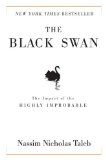“The Black Swan” by Nassim Nicholas Taleb is a follow-up to his last book “Fooled by Randomness”. A Black Swan is a completely unforeseen event with significant consequences. It could be the sudden crash of the stock market after a prolonged bull phase or the unexpected success of a book by a previously-unknown author. The term refers to the shattering of the long-held idea of a swan always being white by the sighting of black swans in the newly-discovered land of Australia. The book is a warning against using induction to derive conclusions that are then prone to Black Swans.
The author divides our observations of the world around us into those belonging to “Mediocristan” and “Extremistan”. In Mediocristan, there are no very large deviations from the normal over many observations. In Extremistan, you might run into observations deviating significantly from the normal. For example, the height or weight of people do not have very large variations (Mediocristan), while the wealth of people does (Extremistan). Black Swans occur in Extremistan.
The author shows how to differentiate between data that belong to Mediocristan and data that belong to Extremistan. This allows you to be on your guard against Black Swans and to insure yourself against their impact. Of course, this is much easier said than done.
As in the previous book, the author mulls over a lot of topics that I have been thinking about but have not seen much written about. These include:
- A thousand experiments are insufficient to prove a theory but a single experiment is sufficient to disprove it.
- Modern finance uses a lot of mathematics to give an appearance of certainty, but the underlying assumptions are so flawed that the formulae are useless.
- The normal distribution is applied to a lot of places where it is not at all applicable.
- Pascal's wager assumes that if a god exists it is naive enough to overlook a feigned devotion to itself.
- People tend to assign precise probabilities to events where it is not really possible to do so.
Of course, this could simply mean that I am not that well-read. There are also discussions about the confusion between correlation and causation and between “absence of evidence” and “evidence of absence”, which commonly lead people into deriving the wrong conclusions from data.
The author warns against the increasing globalisation of finance and the consolidation of smaller financial institutions into bigger ones. While this makes the financial system resilient to small shocks, it leaves it quite vulnerable to huge systemic shocks since everything is now inter-linked. In the light of the recent economic shocks, the author appears fairly prescient here.
Many of my complaints about the previous book apply to this book as well. The author also falls for many of the ills that he cautions against in this book. For example, after having cautioned us to the perils of trying to look for normal distributions everywhere, the author tries to apply fractals to several places where it requires a bit of a stretch of the imagination. After having cautioned us to the ills of deriving conclusions from statistically-insignificant samples, the author refers to a study deriving conclusions from a sample of Oscar-winning actors.
